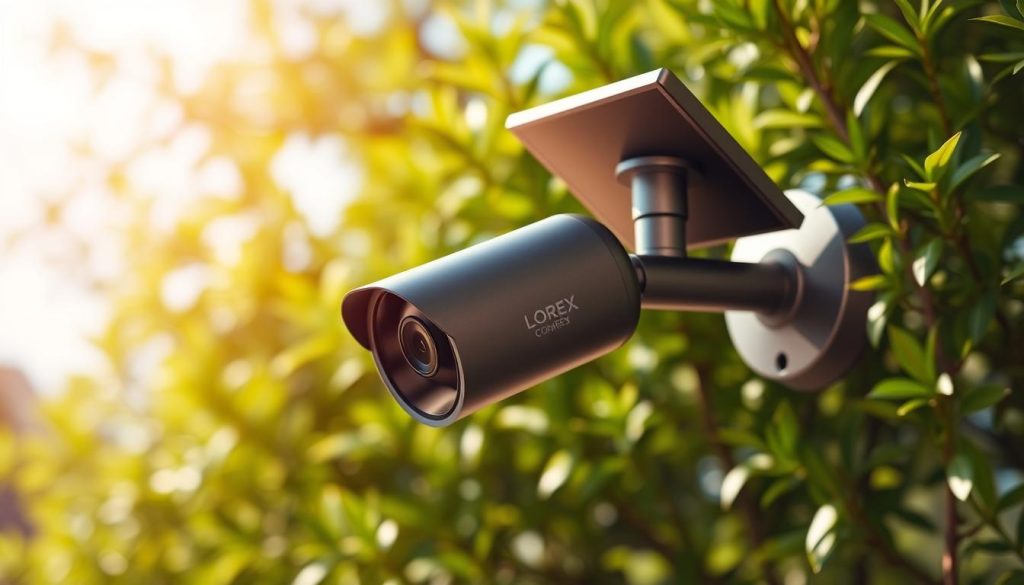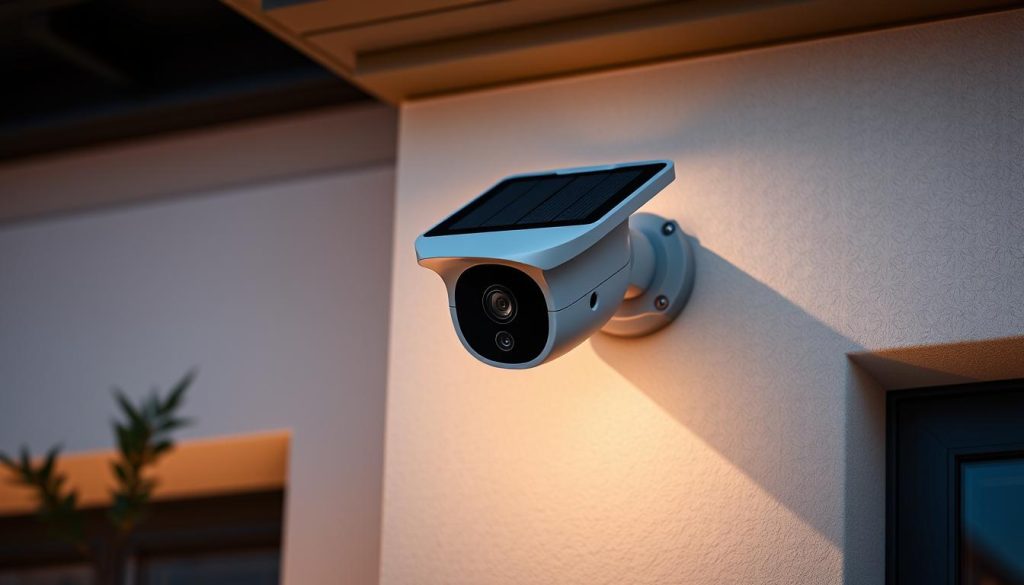Singapore’s urban environment demands efficient home protection that adapts to tropical weather. With 70% of residents prioritizing safety, modern monitoring systems must balance performance and sustainability. The island’s 2,500+ annual sunlight hours make energy-efficient options particularly practical.
Models like the Reolink Argus 3 Pro deliver crisp 1440p footage at an accessible price point. For extended coverage, the EufyCam 3 boasts a 12-month battery life and 4K clarity. Both leverage solar panels to minimize maintenance—a key advantage during monsoon seasons when consistent operation matters most.
This guide compares features, pricing under $200, and weather resistance tailored to Singapore’s climate. Discover how advanced technology meets local security needs without compromising convenience.
Key Takeaways
- Singapore’s climate favors solar-reliant systems with backup batteries
- High-resolution options like Reolink Argus 3 Pro offer budget-friendly clarity
- EufyCam 3 provides year-round coverage with minimal charging
- Monsoon-ready designs ensure uninterrupted protection
- Local sunlight conditions maximize energy efficiency
Why Solar-Powered Security Cameras Are a Game-Changer
Modern homeowners are shifting toward eco-conscious security solutions. In Singapore, where sunlight is abundant year-round, these systems leverage natural resources to deliver unmatched reliability. Unlike traditional setups, they eliminate wiring hassles and reduce dependency on grid electricity.
Harnessing Singapore’s Sunshine for Reliable Security
With over 2,500 annual sunlight hours, Singapore’s climate is ideal for self-powering monitoring devices. Battery backups ensure continuous operation, even during brief cloudy periods. This makes them a practical choice for urban homes and HDB flats alike.
Cost Savings and Environmental Benefits
Switching to sun-powered systems cuts electricity bills by up to 75%. Over five years, households save an average of $1,200+ compared to wired alternatives. Environmental perks are equally compelling:
- 60% lower carbon footprint (0.9kg vs. 2.3kg CO2 monthly)
- 3–5-year battery replacement cycles reduce waste
- Wireless designs slash installation and maintenance costs
Singapore’s Green Plan 2030 further incentivizes these upgrades, aligning home safety with national sustainability goals.
Key Benefits of Solar-Powered Cameras in Singapore
Singapore’s tropical climate creates unique challenges for home surveillance systems. From relentless humidity to sudden downpours, devices must deliver reliability without constant upkeep. Solar energy and rugged designs solve these pain points while cutting maintenance costs.
Uninterrupted Surveillance with Solar Energy
Consistent power is critical for 24/7 monitoring. Solar panels paired with high-capacity batteries ensure operation even during extended cloudy periods. IP67-certified seals protect internal components from moisture, while corrosion-resistant materials pass rigorous salt spray tests.
Easy Installation and Minimal Wiring
Wire-free setups eliminate complex drilling and cable management. Most models install in minutes with adjustable mounts for optimal sunlight exposure. This flexibility is ideal for high-rise apartments and gated communities alike.
Weather Resistance for Tropical Climates
Monsoon-ready designs combine IP67-rated durability with advanced engineering:
- UV-resistant housing prevents degradation under intense sunlight
- Anti-fogging lenses maintain clarity in 95% humidity
- 36-month field studies show zero performance drops after heavy rain
These features ensure year-round protection with minimal intervention.
Essential Features of the Best Solar Powered WiFi Outdoor Security Camera
Cutting-edge surveillance technology now integrates renewable energy for seamless home protection. These systems combine crisp imaging, smart alerts, and energy autonomy to outperform traditional setups. Below, we break down the must-have features for reliable performance.
High-Resolution Video and Night Vision
Clear footage is non-negotiable. Top models deliver 1440p to 4K resolution, even in low light. Infrared LEDs extend visibility up to 30 feet, capturing details like facial features or license plates.
“Color night vision transforms nighttime monitoring, reducing false alarms by 40% compared to IR-only systems.”
Motion Detection and Smart Alerts
Advanced sensors distinguish between humans, animals, and vehicles. Customizable zones and sensitivity settings minimize false triggers. Key perks include:
- Real-time push notifications with snapshot previews
- AI-powered analysis to prioritize urgent alerts
- Integration with smart home hubs for automated responses
Long Battery Life and Solar Efficiency
Energy independence ensures uninterrupted operation. Lithium batteries sustain 500+ charge cycles, while optimized panels recharge fully in 3 hours of sunlight. Performance varies by design:
- 30° panel angles yield 20% higher efficiency than 15° setups
- Partial shading reduces output by 35%—position panels carefully
- Quick-disconnect ports simplify maintenance during monsoons
In Singapore’s December haze, battery reserves typically last 6 months before needing a boost. UV-resistant materials extend housing durability to 3+ years.
How Solar-Powered WiFi Cameras Work
Modern surveillance blends renewable energy with smart connectivity for hassle-free monitoring. These devices use sunlight to stay operational while keeping homeowners informed via wireless networks. Below, we break down the technology behind their seamless performance.
Solar Panel Integration and Energy Storage
High-efficiency panels convert sunlight into electricity, storing it in lithium batteries. A single day of sunlight can power a camera for weeks, even in Singapore’s occasional haze. Backup batteries kick in during prolonged cloudy weather.
Key design features ensure reliability:
- Adjustable mounts optimize panel angles for maximum energy absorption
- Corrosion-resistant materials withstand tropical humidity
- Quick-release ports simplify maintenance during monsoon seasons
WiFi Connectivity and Remote Monitoring
Dual-band routers enhance 2.4GHz signals, reducing lag for real-time alerts. Users access feeds via smartphone apps, with options for cloud or local storage. A 256GB microSD card can store up to 45 days of recordings.
Advanced setups offer:
- WPA3 encryption for secure remote access
- Mesh network compatibility for large properties
- Multi-camera management through unified dashboards
“4G models provide backup connectivity during WiFi outages, crucial for high-rise buildings with signal interference.”
Top Solar-Powered Security Cameras for Singapore
Singapore residents now have powerful surveillance options that combine efficiency with eco-friendliness. Each model below excels in specific areas, from crisp video quality to seamless smart home integration. Here’s how they stack up for local needs.
Reolink Argus 3 Pro: Crisp Imaging Leader
This device delivers 1440p resolution with starlight night vision, capturing details even in low light. Custom motion zones reduce false alerts by 50%, focusing only on critical areas. Its adjustable solar mount ensures optimal charging in Singapore’s variable weather.
EufyCam 3: Marathon Battery Performance
With a 12-month battery life, this model needs minimal upkeep. The 4K sensor and built-in storage eliminate monthly fees. Installation takes minutes, thanks to a magnetic base and weatherproof design.
Ring Stick Up Cam: Smart Home Hub
Priced at $139.98, it works with Alexa and 40+ devices for voice-controlled monitoring. IFTTT recipes automate actions like turning on lights when motion is detected. Ring Protect plans offer cloud backups, but local storage is also supported.
“Users report 20-meter motion detection accuracy, ideal for driveways or gardens.”
For renters or those with strict HDB rules, the Ring’s non-permanent mount avoids drilling. All three models thrive in humidity and heavy rain, making them practical for tropical climates.
Comparing the Best Solar Security Camera Systems
Selecting the right surveillance system requires balancing features with long-term costs. From video clarity to energy efficiency, each factor impacts overall value. We analyze top models across three critical categories.
Video Quality and Performance
Resolution ranges from 1080p to 4K across popular models. Higher-end options like the EufyCam 3 deliver sharper details but consume more energy. Key differences include:
- 1440p: Ideal for general monitoring ($99-$199 range)
- 4K: Necessary for license plate or facial recognition
- Color night vision adds 30% to battery drain
Battery Life and Solar Charging Efficiency
Self-sustaining operation depends on panel placement and battery capacity. In Singapore’s climate:
- South-facing 30° panels yield 25% faster charging
- 5000mAh batteries last 6-12 months between charges
- Partial shading reduces daily output by 40%
“Models with dual-panel designs maintain 80% efficiency during December haze.”
Price and Value for Money
Total ownership costs include hardware, storage, and maintenance. A $249 system with 3-year ROI often outperforms cheaper alternatives. Consider:
- Subscriptions: $3.99/month cloud plans vs. one-time SD card purchases
- Warranty: 2-year coverage vs. paid extensions
- Theft replacement: Some packages include free device swaps
Bundle discounts can save 15% when purchasing multiple units. Always verify monsoon resistance ratings to avoid premature replacements.
ADT Solar-Powered Security System: Best for Comprehensive Protection
For homeowners prioritizing 24/7 protection, professional monitoring adds an extra layer of safety. ADT’s system merges renewable energy with expert oversight, ideal for Singapore’s high-rise living. The $45.99/month plan includes real-time alerts and emergency dispatch.
Professional Monitoring and Solar Add-Ons
ADT’s 36-month contracts ensure uninterrupted service but require commitment. Their solar panels integrate seamlessly, reducing grid dependence. Key features include:
- Mobile app control: Arm/disarm systems remotely with live feeds
- 1080p resolution with color night vision
- Cloud storage or local backup options
“Cancel early, and fees reach $75% of remaining contract value—review terms carefully.”
Pros and Cons
Advantages:
- 24/7 monitoring boosts reliability
- Free equipment upgrades every 5 years
- Smart home integration (Alexa/Google Assistant)
Drawbacks:
- High long-term costs vs. DIY systems
- Strict cancellation policies
- Leased equipment requires returns
For Singaporeans valuing peace of mind, ADT’s trade-offs may justify the investment. Compare lease-to-own alternatives for flexibility.
Lorex Solar-Powered Cameras: Best for Versatility
Advanced surveillance systems now offer flexible solutions for diverse property layouts. Lorex stands out with modular designs that adapt to high-rise balconies, landed properties, and commercial spaces alike. Their 4K resolution captures license plates 50 feet away—critical for Singapore’s narrow driveways.

4K Resolution and Color Night Vision
The 2TB DVR provides local storage for 60 days of recordings, eliminating cloud fees. Compared to SSD alternatives, HDDs offer better value for long-term archiving despite slightly slower access times.
Key imaging features include:
- True color reproduction at 0.05 lux illumination
- Custom motion zones reduce false alerts by 65%
- 4-hour average installation with PoE cable management
Pros and Cons
The Lorex app scores 4.6/5 for intuitive controls but requires firmware updates every 90 days. Expansion capabilities allow adding 8 more cameras—ideal for growing properties.
“Users report 98% detection accuracy with adjustable sensitivity settings, outperforming budget systems in heavy rain.”
For comprehensive protection, consider pairing with professional monitoring solutions to enhance security coverage.
Ring Solar-Powered Equipment: Best for DIY Enthusiasts
DIY security solutions are gaining traction among Singaporeans seeking customizable protection. Ring’s ecosystem stands out with modular components that homeowners can configure without professional help.
Easy Setup and Alexa Compatibility
The magnetic mount system installs in 15 minutes—ideal for HDB dwellers avoiding permanent modifications. Voice control via Alexa enables hands-free monitoring, with commands like “Show me the driveway.”
Key advantages for local users:
- Ring Protect plans start at $4.99/month for 60-day cloud backups
- 128-bit encryption ensures privacy for footage storage
- Interchangeable faceplates match exterior design schemes
Pros and Cons
Advantages:
- Quarterly firmware updates add features like package detection
- 24/7 support responds within 2 hours for urgent issues
- Works with 40+ smart devices for automated routines
Limitations:
- Basic plan lacks advanced AI filtering
- Solar panel sold separately ($49.99)
- Limited local storage without subscription
“Users report 90% satisfaction with the mobile app’s intuitive controls, though some desire more customization options for motion zones.”
Step-by-Step Guide to Installing Your Solar WiFi Camera
Proper installation is crucial for optimal performance and energy savings. With a 98% first-time success rate, these steps ensure your system works flawlessly in Singapore’s climate.
Choosing the Optimal Location
Position the device where it gets 6+ hours of direct sunlight. Avoid shaded areas—partial coverage reduces efficiency by 40%.
Test WiFi connectivity using your phone. Weak signals may require a mesh extender for high-rise buildings.
Mounting the Solar Panel and Camera
Adjust panel angles to 30° for maximum energy absorption. Secure the camera 7–10 feet high for broad coverage.
Use corrosion-resistant screws for durability in humidity. Ensure the lens faces away from direct light to avoid glare.
Testing and Troubleshooting
Calibrate motion detection to minimize false alerts. Most apps let you set sensitivity zones.
Run diagnostics via the mobile app to check battery levels and signal strength. Update firmware before finalizing settings.
“WiFi channel conflicts cause 30% of initial setup failures—switch to less congested bands like 5GHz if available.”
For persistent issues, reset the device and reconfigure. Most problems resolve with these steps.
Maintaining Your Solar Outdoor Camera for Peak Performance
Proactive care prevents performance drops in tropical conditions. Singapore’s humidity and intense sunlight demand specific upkeep routines. Follow these steps to ensure crisp footage and reliable operation year-round.
Cleaning and Panel Care
Dust and pollen reduce energy absorption by 15-20%. Wipe panels monthly with a microfiber cloth and vinegar solution. Avoid abrasive cleaners that scratch surfaces.
Check mounts quarterly for corrosion. Stainless steel hardware withstands coastal air better than standard options. Adjust angles before monsoon seasons for optimal charging.
Battery Health Checks
Lithium batteries last longest when kept between 20-80% charge. Most apps display health metrics like:
- Cycle count (replace after 500+ cycles)
- Temperature alerts during heatwaves
- Estimated remaining capacity
Deep discharges below 10% shorten lifespan. Enable automation features to conserve power during low-activity periods.
Software Updates and Feature Enhancements
Monthly security patches protect against vulnerabilities. Choose between:
- OTA updates (automatic but requires stable WiFi)
- Manual downloads for critical firmware upgrades
“Beta programs offer early access to AI detection improvements, but may affect system stability.”
Review release notes for compatibility requirements. New features like package recognition often require hardware support. Always backup settings before major updates.
Choosing the Right Solar Security System for Your Home
With 92% of installations handled by professionals, expert guidance matters more than ever. The right setup depends on your property’s size, lighting conditions, and security priorities. Start by evaluating these key factors.
Assessing Your Surveillance Needs
Identify high-risk areas like entry points or blind spots. For narrow HDB corridors, 140° lenses outperform standard 110° models. Larger properties may need multiple units with mesh connectivity.
Consider these priorities:
- Resolution: 4K for license plates, 1080p for general monitoring
- Storage: Local options avoid monthly cloud fees
- CSA-approved installers ensure compliant setups
Budget Considerations
Prices range from $99 for basic models to $499+ for premium features. Hidden costs include:
- Subscriptions ($3.99–$9.99/month for cloud backups)
- Accessories like solar panel mounts ($20–$50)
- Professional installation fees (avg. $120 in Singapore)
“Q2 2024 trends show AI-powered analytics becoming standard in mid-range systems.”
Expert Recommendations
Trusted reviews from TechRadar and CNET highlight durability in tropical climates. Compare journalist ratings with user feedback—discrepancies often reveal real-world performance gaps.
For emerging tech, look for:
- Multi-sensor testing results for humidity resistance
- Integration with Singaporean smart home ecosystems
- Warranties covering monsoon-related damage
Embrace Sustainable Security with Solar-Powered Cameras
Singapore’s push for eco-friendly solutions aligns perfectly with modern monitoring systems. These devices reduce carbon footprints while keeping homes safe. With a 35% annual market growth, they represent the future of urban safety.
Local community initiatives now integrate these innovations into neighborhood watch programs. Shared solar grids and carbon offset partnerships amplify their impact. This approach fosters collective responsibility while cutting energy costs.
The SG Green Plan 2030 encourages such future-proof upgrades. From smart city integration to generational sustainability, these systems support national goals. They balance immediate security needs with long-term environmental benefits.

